RogueRose
International Hazard
    
Posts: 1585
Registered: 16-6-2014
Member Is Offline
|
|
Rusty nails in HCl - interesting reaction when heat applied
So I had some really rusty nails and I was planning on making FeCl3 so I thought the rust would make this then the HCl would dissolve the iron and I'd
have a mix of FeCl2 and FeCl3 - then I would bubble Cl gas through to get pure FeCl3.
So I filled a glass bottle with nails then added the HCl. some bubbling occurred slowly which I think is the O2 being released. There was some
chlorine smell but it was pretty mild. The liquid looked dark brown to black in the bottle but was yellow on a paper towel. Small clear crystals
(looked like salt) formed on the nails and the same formed on the bottom of the bottle but this looked like salt/sand mix.
I could see the nails that were touching the side of the glass but even 2-3mm of coverage by the liquid obscured any view even with light. There were
some black flakes floating around which I suspect is carbon.
I decided to heat the bottle a little so I filled a gallon jug with hot tap water (135F) and placed the bottle in it and allowed to sit for 4 hours.
When I checked the liquid had cleared and I could see at least an inch or so into the bottle, there was a lot more crystals on the nails and the
precipitate had greatly increased on the bottom. There were also a lot more bubbles coming off than previously.
I decided to repeat this and changed the water out and see what happens.
Can anyone tell me if my theory on what will be formed (the two chlorides) and why the solution clarified with a little heat? Was this due to the
heat or was it a coincidence that something like the free Cl in the HCl reached a low enough level for things to drop out (or something like that - I
don't know what would cause this.)
I just checked 20 mins after adding the new hot water and it is bubbling a good bit (much more than without heat). The odd thing is that there is a
strange smell coming off of it. It smells "boggy" or like an old rotting damp wood foundation basement, or some funky old plat pots that have been
sitting outside for years (decade) and have been soaked the whole time. Don't ask how I know these smells, it was never pleasent. It seems more like
sulfurish smell than anything related to Cl.
[Edited on 8-5-2017 by RogueRose]
|
|
|
softbeard
Hazard to Self
 
Posts: 69
Registered: 23-7-2013
Member Is Offline
Mood: moody
|
|
RogueRose, I'm pretty sure the bubbling you saw was H2 gas from iron metal reacting with your hydrochloric acid. There would be no source for O2 gas
bubbles or any free chlorine present in what is a reducing environment.
The rust on the nails, if you assume that to be Fe2O3.xH2O, will initially give you FeCl3 as it dissolves in hydrochloric acid. But, in the presence
of excess Fe metal, this gets reduced back to FeCl2. To complicate matters more, the FeCl2 slowly absorbs O2 from the air to give FeCl3.
So you see, you've got a lot of things going simultaneously. All these reactions dependent on concentration and temperature, so it's no wonder you
might have different color changes.
I won't get into pH effects on the various iron (III) chloride-hydroxide complexes.
To keep it simple, so long as you have a loose (pressure buildup!) lid on your container and have excess iron and HCl, you'll be making FeCl2. This
crystallizes as the pale blue-green tetrahydrate FeCl2.4H2O and is probably the crystals you've seen.
The carbon in the steel will come out as graphite flakes, as you noted.
Finally, that wonderfully 'boggy' odor you mention is probably mainly due to phosphine (PH3). There is a small amount of phosphorus in the steel and
this is where it ends up. Avoid breathing it, but don't panic too much. The quantities evolved are miniscule.
edit:spelling
[Edited on 9-5-2017 by softbeard]
|
|
|
RogueRose
International Hazard
    
Posts: 1585
Registered: 16-6-2014
Member Is Offline
|
|
Quote: Originally posted by softbeard  | RogueRose, I'm pretty sure the bubbling you saw was H2 gas from iron metal reacting with your hydrochloric acid. There would be no source for O2 gas
bubbles or any free chlorine present in what is a reducing environment.
The rust on the nails, if you assume that to be Fe2O3.xH2O, will initially give you FeCl3 as it dissolves in hydrochloric acid. But, in the presence
of excess Fe metal, this gets reduced back to FeCl2. To complicate matters more, the FeCl2 slowly absorbs O2 from the air to give FeCl3.
So you see, you've got a lot of things going simultaneously. All these reactions dependent on concentration and temperature, so it's no wonder you
might have different color changes.
I won't get into pH effects on the various iron (III) chloride-hydroxide complexes.
To keep it simple, so long as you have a loose (pressure buildup!) lid on your container and have excess iron and HCl, you'll be making FeCl2. This
crystallizes as the pale blue-green tetrahydrate FeCl2.4H2O and is probably the crystals you've seen.
The carbon in the steel will come out as graphite flakes, as you noted.
Finally, that wonderfully 'boggy' odor you mention is probably mainly due to phosphine (PH3). There is a small amount of phosphorus in the steel and
this is where it ends up. Avoid breathing it, but don't panic too much. The quantities evolved are miniscule.
edit:spelling
[Edited on 9-5-2017 by softbeard] |
Thanks for the explination! I took some pics which I will post shortly as I just had an interesting color change in the precipitate to the nice green
FeCl2 and the smell is the same which I have not placed as what I remember methane to smell like - which lines up with my reference to a boggy smell.
IDK how that is forming or if it is that, I may try to collect some and see if it lights.
As a side note, I think some of the rust was from a solution of oxalic acid which was evaporated with the nails in it but it was heated to 350-450F
during evaporation. It was completely rust (brown-red) colored and had the same consistence. It reacted the same way as rust produced with steel
wool and bleach - so I thought it was the same.
Could the oxalic acid (residuals) be causing the methane smell?
|
|
|
RogueRose
International Hazard
    
Posts: 1585
Registered: 16-6-2014
Member Is Offline
|
|
Here are some pics after the first addition of hot water. It has changes somewhat since then oddly enough with the crystals on the bottom changing
color to a more sand color. I added near boiling water instead of just hot tap water and the bubbling increased by probably 400-500% from the 135
degree water.
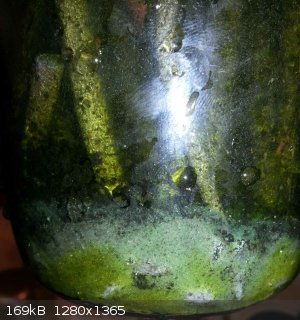 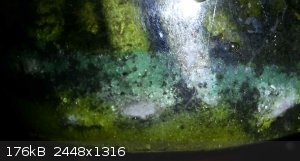 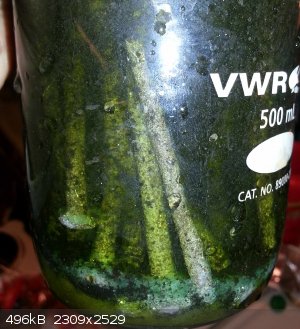 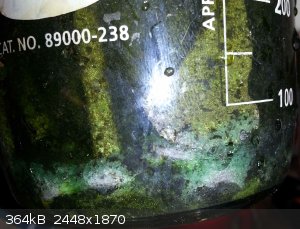
[Edited on 9-5-2017 by RogueRose]
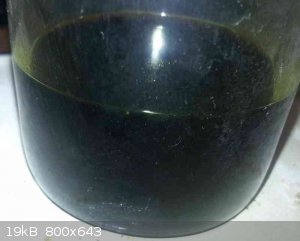
|
|
|
Deathunter88
National Hazard
   
Posts: 507
Registered: 20-2-2015
Location: Beijing, China
Member Is Offline
Mood: No Mood
|
|
Quote: Originally posted by RogueRose  | Quote: Originally posted by softbeard  | RogueRose, I'm pretty sure the bubbling you saw was H2 gas from iron metal reacting with your hydrochloric acid. There would be no source for O2 gas
bubbles or any free chlorine present in what is a reducing environment.
The rust on the nails, if you assume that to be Fe2O3.xH2O, will initially give you FeCl3 as it dissolves in hydrochloric acid. But, in the presence
of excess Fe metal, this gets reduced back to FeCl2. To complicate matters more, the FeCl2 slowly absorbs O2 from the air to give FeCl3.
So you see, you've got a lot of things going simultaneously. All these reactions dependent on concentration and temperature, so it's no wonder you
might have different color changes.
I won't get into pH effects on the various iron (III) chloride-hydroxide complexes.
To keep it simple, so long as you have a loose (pressure buildup!) lid on your container and have excess iron and HCl, you'll be making FeCl2. This
crystallizes as the pale blue-green tetrahydrate FeCl2.4H2O and is probably the crystals you've seen.
The carbon in the steel will come out as graphite flakes, as you noted.
Finally, that wonderfully 'boggy' odor you mention is probably mainly due to phosphine (PH3). There is a small amount of phosphorus in the steel and
this is where it ends up. Avoid breathing it, but don't panic too much. The quantities evolved are miniscule.
edit:spelling
[Edited on 9-5-2017 by softbeard] |
Thanks for the explination! I took some pics which I will post shortly as I just had an interesting color change in the precipitate to the nice green
FeCl2 and the smell is the same which I have not placed as what I remember methane to smell like - which lines up with my reference to a boggy smell.
IDK how that is forming or if it is that, I may try to collect some and see if it lights.
As a side note, I think some of the rust was from a solution of oxalic acid which was evaporated with the nails in it but it was heated to 350-450F
during evaporation. It was completely rust (brown-red) colored and had the same consistence. It reacted the same way as rust produced with steel
wool and bleach - so I thought it was the same.
Could the oxalic acid (residuals) be causing the methane smell? |
It would be wise to note that methane has no smell.
|
|
|
RogueRose
International Hazard
    
Posts: 1585
Registered: 16-6-2014
Member Is Offline
|
|
Quote: Originally posted by Deathunter88  |
That is a good point. I looked at the phosphine page and it does mention smell and that is similar to what I am noticing. IDK if anyone has smelled
this and H2S and how they compare but I think they have a somewhat similar smell to a degree or they both remind me of the same things (old septic
systems or similar).
thanks for mentioning that CH4 doesn't have a smell or I would have falsely believed that it was this and maybe some phosphine mixed in as well.
|
|
|
|
MrHomeScientist
International Hazard
    
Posts: 1806
Registered: 24-10-2010
Location: Flerovium
Member Is Offline
Mood: No Mood
|
|
I've noticed that awful smell whenever I dissolve "hardware store grade" iron; nails, steel wool, hard drive magnets, etc. I never really knew what
caused it. Phosphine is an interesting possibility.
softbeard has some great info in his post. With all that iron metal present, FeCl<sub>2</sub> will be the dominant
product. Those are the light green sandy crystals you see in the pictures. Those are hard to keep that way - they eventually oxidize to iron(III) over
time. You can purify them by filtering them off, adding enough water to dissolve everything, filtering again to remove carbon bits, then allowing to
crystallize. Adding some fresh iron to the crystallizing solution should help keep it as iron(II).
The increase in bubbling you saw when the water was heated is from the reaction rate increasing with temperature; a universal occurrence in chemistry.
|
|
|
softbeard
Hazard to Self
 
Posts: 69
Registered: 23-7-2013
Member Is Offline
Mood: moody
|
|
Yes, those pictures bring back memories; especially memories of that smell! The pale-blue green FeCl2.4H20 crystals is what I had tried to collect in
my youth, but these crystals would quickly lose that bluish color and become more green, then yellowish green as they oxidized, exposed to air.
Maybe you could store the FeCl2.4H20 crystals under CO2 to preserve them if that's what you want to try. Propane, propylene, butane,
1,1,1,2-tetrafluoroethane (Dust-Off), N2 or Ar will all work as alternative inert atmospheres. Pick your most convenient/safest.
More regarding 'that smell'. I'm almost certain it's caused primarily by phosphorus hydrides, though not necessarily pure phosphine. Traces of
phosphorus hydrides other than PH3 (eg., P2H4; the stuff that's actually spontaneously flammable) are probably generated.
Regarding collecting and characterizing this smelly gas: remember it's almost pure H2 with some HCl and H20 vapor. There is no way you will have
sufficient phosphorus hydrides generated in this mix of vapors coming from your dissolving Fe nails to make them spontaneously flammable.
In any case, no steel product has that much phosphorus in it.
Best to avoid the stinky stuff and vent it out, unless you have a use for impure H2.
I agree with, MrHomeScientist. There is probably some S in the steel too and that will come out mainly as H2S in this acidic/reducing environment.
Again, the amounts are miniscule, but it may contribute to the odor.
|
|
|
RogueRose
International Hazard
    
Posts: 1585
Registered: 16-6-2014
Member Is Offline
|
|
Ok, something REAALLY odd has started to happen. The level of the liquid inside the bottle is about 1" to 1.5" below the top lip. With the bubbles
there may be .8" minimum but probably 1.3-.8" remaining to the top of the bottle. The bubbles are continuing as the hot water is replaced (with
boiling water). The liquid is no longer clearish as it was after the first addition of hot water bath. In addition, the water bath is turning BROWN
(three batches now!!) and it doesn't smell and I've changed containers so it isn't the water bath vessel.
Also all the precipitate has disappeared and looks like it has re-deposited on the nails and they look white/clear-ish and also some very light green.
There is still the carbon floating around but the liquid is dark yellow and I can't see a nail 5mm deep into the bottle.
After the second time of adding boiling water when I came back about 1" of liquid had disappeared from the bottle. I can tell that a fair amount of
mass has dissolved from the nails as I can shake the bottlle and it now rattles nicely where before there was no room to move.
I can't see that any of the FeCl2/3's could have decompsed as they will stay hydrated at those temps and then the anhydrous decomp's at much higher
temps. Nothing else has been added.
The solution is still acidic but I don't know how what concentration is left, say if 50%, 20%, 4% is left or what.
I did remove about 20ml of liquid and filtered with coffee filter to get the black stuff out and the remaining liquid was an olive oil like green, or
maybe grape-seed oil.
My plan isn't to dissolve all the nails, just to make some FeCl3 for circuit board etching and a few other things. I do have some 35% H2O2 which I
know will convert the FeCl2 into Cl3 or I can bubble air. I'm mainly worried about the brown bath water and if that could be from the phosphine
bubbling out. I tried a PETE container to hold the water and stainless steel and it is the same for both, so it isn't the material.
Any ideas as to what this could be and why things are happening like this?
|
|
|
Rhodanide
Hazard to Others
  
Posts: 348
Registered: 23-7-2015
Location: The 80s
Member Is Offline
Mood: That retro aesthetic
|
|
I got something similar when using stainless Fe nails to electrolyze a NaCl solution. I can't help but think of Cr2O3 when I see it. I don't know, is
there even any Cr metal in stainless steel or nails? It just screamed Chromium Oxide when I saw it first.
|
|
|
Corrosive Joeseph
National Hazard
   
Posts: 915
Registered: 17-5-2015
Location: The Other Place
Member Is Offline
Mood: Cyclic
|
|
"All stainless steels contain a minimum of 10.5% chromium"
http://www.eurofer.org/Eurofer%20Stainless/About%20Stainless...
/CJ
Being well adjusted to a sick society is no measure of one's mental health
|
|
|
woelen
Super Administrator
        
Posts: 7976
Registered: 20-8-2005
Location: Netherlands
Member Is Offline
Mood: interested
|
|
The trouble with this kind of experiments is that the materials are very impure. The green color almost certainly is due to the presence of chromium
in the steel. The black stuff is from carbon, the smells from phosphorus and (possibly) sulphur. You may even have some antimony in the steel, which
leads to white precipitate and there can be many other small amounts of impurities which can make it very hard to determine the precise nature of your
products.
A general observation I made in numerous experiments: When the color of a liquid/solution is brown, or has another color with a strong shade of brown
(e.g. olivegreen, red/brown, orange/brown), then in many cases this means that you have a complicated mix of different colored species. Brown colors
usually are not a good sign when it comes to understanding precisely what is going on.
|
|
|
RogueRose
International Hazard
    
Posts: 1585
Registered: 16-6-2014
Member Is Offline
|
|
Thanks for the explinations. These nails are probably 40-70 years old (probably towards that later part of that time frame) and were used in wooden
bridge construction - pulled from the ashed of the burn't wood.
What I'm struggling with is the water bath water turning a muddy brown. The water only copmes to the neck of the reagent bottle , 1/3" below the cap,
and I've had 4 batches turn a completely muddy color, with a hint of red/brown. It really looks like rust.
I used an old 1 gal PETE bottle the first 3 times and it got muddy then a stainless steel vessel and it did the same thing, so I think it is something
going on with the gases coming out maybe??
There is no liquids bubbling down and into the water bath as wiping with a tissue around the edge reveals a clean surface.
|
|
|
AJKOER
Radically Dubious
    
Posts: 3026
Registered: 7-5-2011
Member Is Offline
Mood: No Mood
|
|
Here is a different path. Add cold seltzer water (largely aqueous CO2) to Iron filings. The corrosion reaction is said to procedure via a soluble Fe
complex (see http://www.corrosionjournal.org/doi/pdf/10.5006/0010-9312-36... ).
I suspect the reaction could be accelerated by adding a small amount of sea salt as an electrolyte, given that corrosion reactions, especially with
metal alloys, have an electrochemical nature (see "SIMULATION OF FeCO3 / FeS SCALE FORMATION USING THERMODYNAMIC AND ELECTROCHEMICAL MODELS", by
Andrzej Anderko, link: https://www.google.com/url?sa=t&source=web&rct=j&... ) and as a second source, see also https://books.google.com/books?id=Uuz1Qgi3qLwC&pg=PA214&... . I would do this by wetting the inside of the container's lid holding the
Fe/CO2(aq) mix and sprinkle on the lid some sea salt. Shake out loose salt and screw back on lid. Invert the container to add the sea salt to the
solution, which will also salt out of solution some CO2 gas. Let the mix stand for a few days to create FeCO3 and the soluble complex with also NaCl
and other alloy metal contaminants.
If you need an impure soluble ferrous ion, your done. No strong acid required.
Also, to the product (likely containing unreacted iron), one could add an acid of choice to create the corresponding soluble salt, which is decanted
from the reaction.
----------------------------------------------------
The above stated path may exhibit a different complex color sequence than you observed with HCl. My speculation is since H2CO3 is a much weaker acid
than HCl, my ionic HCO3- route could be more purely electrochemical in nature, which may proceed in a more strict order of electrochemical potential
of the various metals present.
Your cited procedure above has elements of both standard chemical reactions between metals and HCl along with an H+ and O2 (from boiling/heating in
air or sitting in an open vessel) introducing an electrochemical component as well, in my opinion. See my comments and half cell reactions in a prior
thread at https://www.sciencemadness.org/whisper/viewthread.php?tid=73... .
[Edited on 12-5-2017 by AJKOER]
|
|
|
RogueRose
International Hazard
    
Posts: 1585
Registered: 16-6-2014
Member Is Offline
|
|
Here are some pics of more reactions. The first pick are what the water looked like after adding hot water and allowing the bottle to sit in it for
about 3-4 hours (before the bottle was drained). The water was never closer than 1/2" from the cap and the liquid HCl/FeClx level inside was about
1.5" below the top of the bottle. IDK how it keeps getting brown. The next pic is the water settled after 12 hours.
Next 2 pics are from filtering the HCl/FeClx solution and then the filtrate (green)
Then the pics of what the nails looked like after being drained and rinses and then the yellow/green is with fresh HCl added - it has lots of bubbles
that was vigorous for at least 12 hours but slowed after that until placed in hot water bath. The yellow color changed to a clearish grey after
about 2 hours.
The final 2 are in a hot water bath after 4 hours and there is no brown color in the water. Again, the brown water happened in a plastic bath and a
SS bath container.
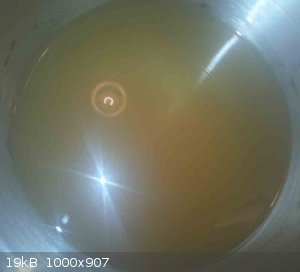 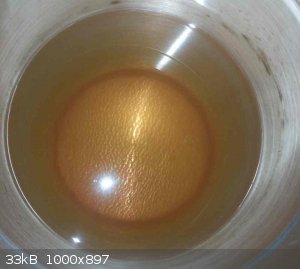 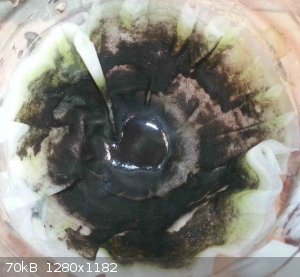 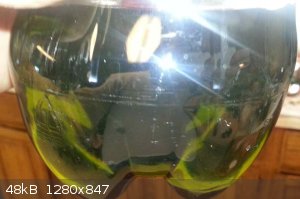 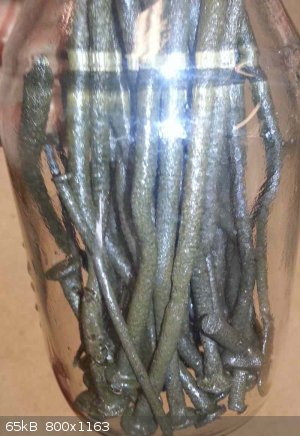 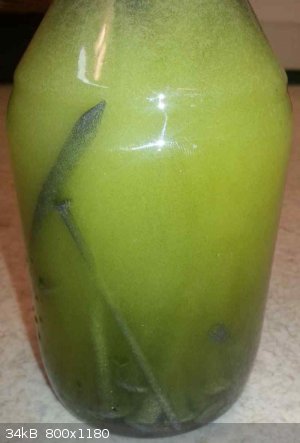 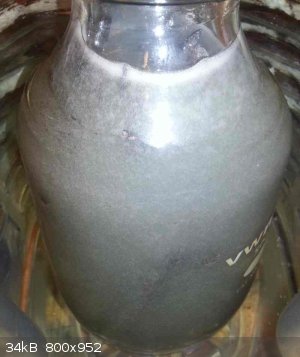 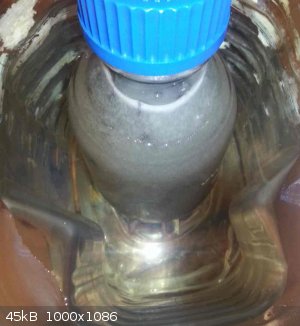
|
|
|
Melgar
Anti-Spam Agent
    
Posts: 2004
Registered: 23-2-2010
Location: Connecticut
Member Is Offline
Mood: Estrified
|
|
Not just from a mixture of yellow iron III and pale blue iron II ions? After all, the yellow Fe(III) is being reduced by the metal to Fe(II).
In my experience, the cheaper the steel, the fewer metals it contains other than iron. Since no metals are cheaper than iron, alloying anything else
with it would make it more expensive. I'm not actually seeing anything yet that can't be explained by iron, carbon, or the various nonmetal-based
baths and pickling agents they use to treat steel.
| Quote: | | A general observation I made in numerous experiments: When the color of a liquid/solution is brown, or has another color with a strong shade of brown
(e.g. olivegreen, red/brown, orange/brown), then in many cases this means that you have a complicated mix of different colored species. Brown colors
usually are not a good sign when it comes to understanding precisely what is going on. |
With iron though, you'll start getting FeCl2OH and species like that if the pH gets too high, and iron hydroxides are typically red-brown. If you try
taking some of the brown stuff out and adding acid to it, and then it turns yellow or a sort of clear yellow-brown, then you'll know your acid is
nearing depletion. Another sign is if you start smelling sulfur species like H2S and SO2, from iron reducing sulfates.
|
|
|
RogueRose
International Hazard
    
Posts: 1585
Registered: 16-6-2014
Member Is Offline
|
|
Thanks for the replies! I didn't even see AJKOER's post (even though I looked many times) until just now...
I don't want to beat a dead horse, but I can't figure out how the water bath water turned brown and then the brown settled out to the bottom of the
container. It seems that something must have come out of the bottle as a gas, and absorb into the water. Maybe while in the water it oxidizes (or as
it moves up the bottle neck - reverses direction when it hits the cap - down/around the threads of the cap and then down to the surface of the water).
It would come in contact with O2 once it exits the cap but it wouldn't have contact with O2 while inside the bottle.
Wiki states that an aqueous solution of FeCl3 is brown. The temps never got above 190F if that matters, so it didn't boil. I'm wondering if once in
solution whether it would settle on the bottom like rust does, or other compounds like that (like MnO2, PbO2, etc..).
I'm going to save what is at the bottom of the water bath, it isn't a lot, let it dry and then see what it might be - but I'm open to speculation.
|
|
|
Melgar
Anti-Spam Agent
    
Posts: 2004
Registered: 23-2-2010
Location: Connecticut
Member Is Offline
Mood: Estrified
|
|
My theory is that you got some Fe(II) chloride mixed in with that water, which is very pale blue in color, and then when it was exposed to oxygen,
that oxidized to FeCl2OH or something similar, which would settle out as a brown precipitate.
Incidentally, this is what happened in the banded iron formations during the Oxygen Catastrophe, and is the source of the majority of our iron ore.
|
|
|
AJKOER
Radically Dubious
    
Posts: 3026
Registered: 7-5-2011
Member Is Offline
Mood: No Mood
|
|
I tested my suggested Ferrous carbonate path with some success (at least enough to produce a visble color change).
In 5 hours, after heating 3 times for 30 seconds in a microwave, and periodic shaking, a mix of water, Iron filings, NaHCO3, to which is added a
small amount of vinegar (the latter two acting as a CO2 source with the Sodium bicarbonate in excess) with a touch of sea salt. I employed a sealed
and deflated plastic 3.3 liter bottle to address the CO2 gas expansion issue on heating. Note, acidic pH, increase in the partial pressure of CO2,
warming, agitation of solution and the presence of chloride and acetic acid are all reported as accelerating the corrosion of steel.
Per my cited reference by Anderko above with respect to a surface reaction forming ferrous carbonate:
Fe + HCO3- ⇒ ≡FeCO3 + H+ + 2e-
Other anodic half reactions:
Fe + OH- ⇒ FeOH + e-
FeOH ⇒ FeOH+ + e-
FeOH+ ⇒ Fe++ + OH-
Net: Fe ⇒ Fe++ + 2e-
Cathodic reaction (my expanded rendition featuring the hydrogen atom radical):
H+ + e- ⇒ .H
.H + .H ⇒ H2
As: HCO3- = H+ + CO3(2-) , we have similarly:
HCO3- + e- ⇒ 1/2 H2 + CO3(2-)
In my opinion, it may be further possible that:
HCO3- + .H ⇒ 1/2 H2 + .CO3-
with the possible transient formation of the carbonate radical anion. Its self reaction is said to proceed as follows:
.CO3- + .CO3- ⇒ CO2 + CO4(2-) (p. 11 at https://www.google.com/url?sa=t&source=web&rct=j&... )
Also, a possible reaction between the hydrogen atom radical (and/or e-) and the acetate anion or undissociated HAc, may account for the reported
acceleration of steel corrosion in the presence of acetic acid (thesis idea?, see https://www.google.com/url?sa=t&source=web&rct=j&... ).
Visible result was a light green solution. See picture in attached document.
Attachment: tp.doc (2.6MB)
This file has been downloaded 357 times
[Edited on 12-5-2017 by AJKOER]
[Edited on 12-5-2017 by AJKOER]
|
|
|
AJKOER
Radically Dubious
    
Posts: 3026
Registered: 7-5-2011
Member Is Offline
Mood: No Mood
|
|
I apologize if my alternate non-HCl path is perceived as off topic.
[Edited on 19-5-2017 by AJKOER]
|
|
|